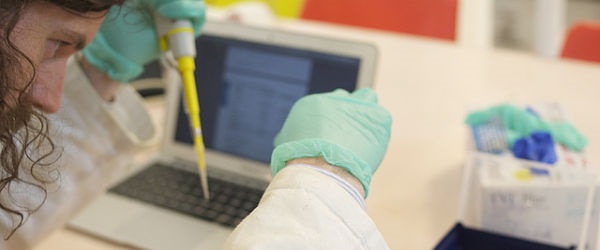Fifty Dollars! That’s all it costs to build your own PCR machine.
Whether you’re a teacher looking to do something different to inspire your students, a student trying to drag out their funding, or maybe you just want to try something cool—like amplifying dinosaur DNA extracted from a mosquito embedded in a lump of amber, conducting criminal forensics for your other job, or want to make your own DNA art—you can do it all with your very own homemade PCR machine.
Why Build Your Own PCR Machine?
Why indeed? Here are four compelling reasons.
1. Save money
Top of the list, of course. It’ll save your lab money; hard-earned grant funding can be better spent on other resources, including paying for your next poster presentation at a conference.
2. Be more eco-friendly
It could be considered more environmentally friendly. If you’ve got most of the components lying around, you may as well build one instead of buying one (costing upwards of $5K) that’ll eventually end up in a landfill.
3. Develop an understanding of PCR
It’ll make you think about what PCR means—the process behind DNA amplification. Instead of just popping your samples into a commercial machine and starting a pre-set program, you’ll get to grips with the whole concept of PCR.
4. It’s fun!
If you enjoy a bit of DIY, then you’ll love this! As intimidating as it may sound, you can build your own machine using tools and equipment you can get easily and without breaking the bank—you’ve probably already got some of them in your garage lab.
An Extremely Short History of PCR
Just as an aside. Did you know that PCR used to be done by hand? Imagine three water baths with thermometers, a timer going off every few minutes, and a PhD student who feels the glamour of being a scientist wearing off, moving tubes from bath to bath. Eek! But the lesson to learn here is that PCR doesn’t need to cost the price of an exotic holiday.
A Bitesize Guide to DIY PCR Machines
So, let’s talk about how to knock off some zeros from the cost of buying and running a PCR machine by building your own!
We’ve put together a summary of the main concepts of a PCR machine, what you need to build one yourself, and all the cheap DIY PCR solutions we’ve managed to source online. We’ll also cover several affordable pre-built devices and options for open-sourcing PCR reagents.
And if we’ve missed anything, please let us know by leaving a comment at the end of this article.
Building a DIY PCR Machine: What You Need
The broader concepts of what you will need to build a PCR machine are summarized in Table 1 below.
Table 1: The components needed to build a PCR machine.
Component | Description |
Temperature Controller | What controls the temperature oscillations during the different phases of PCR reaction? It’s called a thermocycler, a fancy way of saying a temperature controller. You can buy temperature controllers online on sites like Amazon or at your local hardware store. Fancier models are more expensive, but you can get some good deals. So, shop around and be sure to read the reviews before buying. |
Heat Source | This is essential; you can’t cook without a stove. Depending on whose PCR machine you’re going to make, you could be looking at something as simple as a 150-watt lightbulb to a heating block, or you could be looking at building a heating source entirely from scratch. What you do depends on how big of a project you’d like this to be and your own skill level or, more importantly, your level of patience. |
Fan | Making heat is all very well and good, but you’ve got to have a reasonable way of cooling your reaction down. This is where some sort of fan will usually be called for. |
Wires | Some wires and wire cutters are also needed, so all these parts can communicate. |
Support structure | You’ll need a platform to add your tubes and a support structure containing all your other parts. |
Power source | Everybody needs fuel, and your machine will need a power source. |
Brain | Everybody needs a brain, a central chip like an Arduino that acts as the nucleus and tells all the components what they need to do. This is how you program your cycles into your machine; what you connect to monitor the reaction. Essentially, it’s the component that lets you harness the fuel and send it to where it needs to go and when it needs to be there. You’re also going to need some relay to control the flow of the fuel. |
Red button | Not necessarily red, but some way of turning the gadget on and off. |
Interface | A faceplate or computer connected to the machine via a serial cable acts as an interface display (or it’d be like you’re using a computer with the screen off, so you’ve no clue what’s going on!). If you’re building from a kit, the software you’ll need is available for free download (see below). |
Some basic tools | What you need specifically depends on which model you’re trying, but these include electric tape, a soldering iron, screwdrivers, screws, a bandsaw, and a drill press or at least a hand drill. |
Well, what are you waiting for? Let’s build your machine so you can become a multimillionaire by cloning the first dinosaur!
How to Build Your Own PCR Machine
Several decades ago, groups of clever and enthusiastic guys with easy access to technology developed the basis of some of the enormous bioscience companies around today from their garage labs. Universal access to technology has been one of the main driving forces for scientific progress. The possibilities are endless!
A few of these awesome folks have devised ways of making a PCR machine from scratch and made the information open source. The means to build these machines are provided either as pre-manufactured kits or step-by-step recipes to create your own from scratch. The latter call for shopping around for parts and are fairly easy to make. And the overall costs start from as little as $50.
DIY Kits
Table 2 below summarizes all the DIY kits we’ve been able to find out there.
We start with DIY devices that come in kit form, move on to devices you build by sourcing every last component from scratch yourself, and then provide details of a couple of cheaper pre-built solutions.
If you’re looking for DIY devices that you build by sourcing every last component from scratch yourself, the following options will require some more savvy skills, time, troubleshooting, and more specialized equipment to help you on your way.
And, if you refuse to spend any money on a thermocycler, you can make one from a lightbulb and a fan. Moreover, if you have access to a 3D printer, you can make your own qPCR (real-time PCR) machine.
We’re not entirely sure you’d want to submit a research paper on the results you get from any of these, but they could be just the ticket for some of the menial or more unusual applications outlined above.
Table 2: DIY PCR kits and instructions.
Solution | Price* | Description | Application |
DIY Kits | |||
$499 | The low-cost aspect of this kit has enabled numerous students, biohackers, high schools, academic labs, and small companies to perform PCR. | The open-source nature of the kit has allowed researchers to modify the machine to perform PCR and other temperature-controlled reactions in myriad ways beyond what traditional thermocyclers could provide. Researchers have modified it to work with everything from microfluidics to specialized reaction chambers. | |
$99 | Further down the price range is this low-cost, small-size thermocycler that comes as an easy-to-assemble kit and can be run from a simple USB power adapter. | Ideal for fieldwork! We’re thinking the Amazon jungle or African savannah. | |
Build Your Own | |||
< $350 | With an easy-to-follow 10-step guide, this ingenious design uses a metal coffee cup, commercial temperature controller, a temperature probe, heating block, a PC cooling fan, and some basic shop-bought tools. | Can also be used for in situ hybridization experiments. | |
~$300 | This portable qPCR device has no name and no website, but you will require access to a 3D printer to build it. | Designed to provide real-time PCR capabilities out in the field or other resource-limiting settings. [1] | |
$85 | The parts needed to make this device are all off-the-shelf, and the assembly should take just a few hours. It uses an Arduino microcontroller board to regulate two high-power resistors to heat the sample, a fan to cool, and a thermocouple to monitor the temperature. text | Two samples can be processed simultaneously, but it might be possible to add more. You’ll also need a small, old breadboard and access to a band saw and drill press. | |
$50 | The cheapest option we could find, this nifty creation is devised from PVC piping to form a cylinder to hold your samples, a 150-watt lightbulb (to heat), a computer fan (to cool), and a cheap microcontroller (Arduino again). | The ultimate DIY option, ideal for garage lab science! | |
Cheaper Pre-built Solutions | |||
$650 | An innovative 8-well thermal cycler at an affordable price, this compact, fully-featured PCR machine fits on your bench. | Can travel wherever you want to do your science. | |
$5,799–$7,999 | With qPCR machines costing upwards of $20K, the fully portable Chai Biotechnologies option is well worth exploring. | Ideal for taking into the field. The team also provides affordable access to all the necessary reagents by creating a low-cost qPCR master mix incorporating their open-source fluorescent dye. The mix typically sells for upwards of $100 but supports over a hundred experiments. | |
*Prices correct at time of publication and taken from sources. | |||
Sourcing Cheaper PCR Reagents
Of course, the hardware is only half of the equation. You’ll need all the necessary reagents for the PCR reaction too!
We’ve already covered how you can reduce the cost of your PCR by making your own Taq polymerase, and the Chai Biotech solution mentioned in Table 2 above.
You can also access the Open Enzyme Collection from the FreeGenes online catalog. And not just enzymes, but reporters, plasmids, and diagnostics toolkits too—all for free and subject to a signed MTA. Researchers can use the collection as the basis for manufacturing their own enzymes, although you’ll need to subclone them into an expression vector.
The Open Source Bioreactor Project is being developed to grow cells that produce the desired enzymes for molecular biology, such as Taq polymerase. Watch this space!
Other DIY in the Lab Projects
If you’ve successfully assembled all the thermocycler parts above, you’ll have no problem building your own gel electrophoresis system or transilluminator to detect your PCR product.
For more tips, tricks, and hacks for getting your PCR experiments done, including how to make your own chemically competent cells, check out the Bitesize Bio DIY in the Lab Hub.
Originally published May, 2015. Reviewed and updated November, 2022.
References
- Mulberry G et al. (2017) 3D printing and milling a real-time PCR device for infectious disease diagnostics. PLOS ONE 12(6): e0179133.







